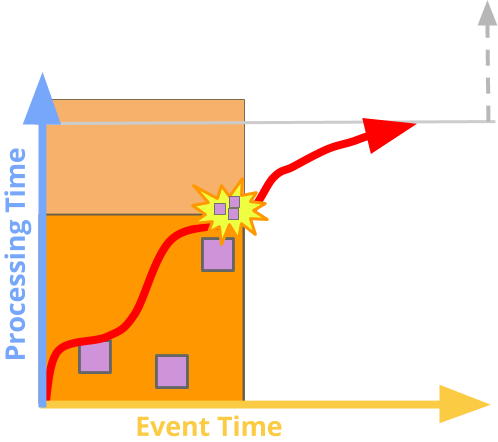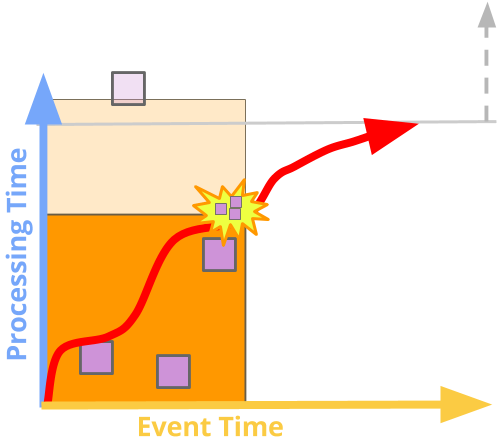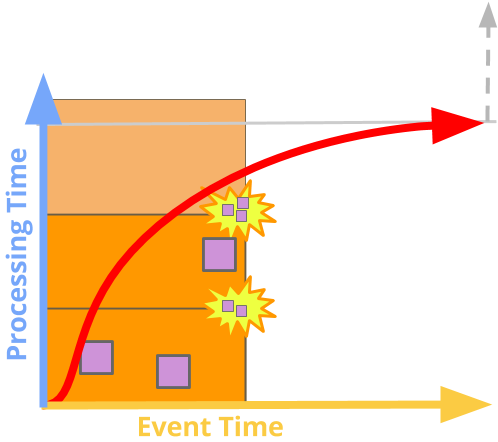blog
2016/10/20
Testing Unbounded Pipelines in Apache BeamThomas Groh
The Beam Programming Model unifies writing pipelines for Batch and Streaming pipelines. We’ve recently introduced a new PTransform to write tests for pipelines that will be run over unbounded datasets and must handle out-of-order and delayed data.
Watermarks, Windows and Triggers form a core part of the Beam programming model – they respectively determine how your data are grouped, when your input is complete, and when to produce results. This is true for all pipelines, regardless of if they are processing bounded or unbounded inputs. If you’re not familiar with watermarks, windowing, and triggering in the Beam model, Streaming 101 and Streaming 102 are an excellent place to get started. A key takeaway from these articles: in realistic streaming scenarios with intermittent failures and disconnected users, data can arrive out of order or be delayed. Beam’s primitives provide a way for users to perform useful, powerful, and correct computations in spite of these challenges.
As Beam pipeline authors, we need comprehensive tests that cover crucial failure scenarios and corner cases to gain real confidence that a pipeline is ready for production. The existing testing infrastructure within the Beam SDKs permits tests to be written which examine the contents of a Pipeline at execution time. However, writing unit tests for pipelines that may receive late data or trigger multiple times has historically ranged from complex to not possible, as pipelines that read from unbounded sources do not shut down without external intervention, while pipelines that read from bounded sources exclusively cannot test behavior with late data nor most speculative triggers. Without additional tools, pipelines that use custom triggers and handle out-of-order data could not be easily tested.
This blog post introduces our new framework for writing tests for pipelines that handle delayed and out-of-order data in the context of the LeaderBoard pipeline from the Mobile Gaming example series.
LeaderBoard and the Mobile Gaming Example
LeaderBoard is part of the Beam mobile gaming examples (and walkthroughs) which produces a continuous accounting of user and team scores. User scores are calculated over the lifetime of the program, while team scores are calculated within fixed windows with a default duration of one hour. The LeaderBoard pipeline produces speculative and late panes as appropriate, based on the configured triggering and allowed lateness of the pipeline. The expected outputs of the LeaderBoard pipeline vary depending on when elements arrive in relation to the watermark and the progress of processing time, which could not previously be controlled within a test.
Writing Deterministic Tests to Emulate Nondeterminism
The Beam testing infrastructure provides the PAssert methods, which assert properties about the contents of a PCollection from within a pipeline. We have expanded this infrastructure to include TestStream, which is a PTransform that performs a series of events, consisting of adding additional elements to a pipeline, advancing the watermark of the TestStream, and advancing the pipeline processing time clock. TestStream permits tests which observe the effects of triggers on the output a pipeline produces.
While executing a pipeline that reads from a TestStream, the read waits for all of the consequences of each event to complete before continuing on to the next event, ensuring that when processing time advances, triggers that are based on processing time fire as appropriate. With this transform, the effect of triggering and allowed lateness can be observed on a pipeline, including reactions to speculative and late panes and dropped data.
Element Timings
Elements arrive either before, with, or after the watermark, which categorizes them into the “early”, “on-time”, and “late” divisions. “Late” elements can be further subdivided into “unobservably”, “observably”, and “droppably” late, depending on the window to which they are assigned and the maximum allowed lateness, as specified by the windowing strategy. Elements that arrive with these timings are emitted into panes, which can be “EARLY”, “ON-TIME”, or “LATE”, depending on the position of the watermark when the pane was emitted.
Using TestStream, we can write tests that demonstrate that speculative panes are output after their trigger condition is met, that the advancing of the watermark causes the on-time pane to be produced, and that late-arriving data produces refinements when it arrives before the maximum allowed lateness, and is dropped after.
The following examples demonstrate how you can use TestStream to provide a sequence of events to the Pipeline, where the arrival of elements is interspersed with updates to the watermark and the advance of processing time. Each of these events runs to completion before additional events occur.
In the diagrams, the time at which events occurred in “real” (event) time progresses as the graph moves to the right. The time at which the pipeline receives them progresses as the graph goes upwards. The watermark is represented by the squiggly red line, and each starburst is the firing of a trigger and the associated pane.

Everything arrives on-time
For example, if we create a TestStream where all the data arrives before the watermark and provide the result PCollection as input to the CalculateTeamScores PTransform:
TestStream<GameActionInfo> createEvents = TestStream.create(AvroCoder.of(GameActionInfo.class))
.addElements(new GameActionInfo("sky", "blue", 12, new Instant(0L)),
new GameActionInfo("navy", "blue", 3, new Instant(0L)),
new GameActionInfo("navy", "blue", 3, new Instant(0L).plus(Duration.standardMinutes(3))))
// Move the watermark past the end the end of the window
.advanceWatermarkTo(new Instant(0L).plus(TEAM_WINDOW_DURATION)
.plus(Duration.standardMinutes(1)))
.advanceWatermarkToInfinity();
PCollection<KV<String, Integer>> teamScores = p.apply(createEvents)
.apply(new CalculateTeamScores(TEAM_WINDOW_DURATION, ALLOWED_LATENESS));we can then assert that the result PCollection contains elements that arrived:

Some elements are late, but arrive before the end of the window
We can also add data to the TestStream after the watermark, but before the end of the window (shown below to the left of the red watermark), which demonstrates “unobservably late” data - that is, data that arrives late, but is promoted by the system to be on time, as it arrives before the watermark passes the end of the window
TestStream<GameActionInfo> createEvents = TestStream.create(AvroCoder.of(GameActionInfo.class))
.addElements(new GameActionInfo("sky", "blue", 3, new Instant(0L)),
new GameActionInfo("navy", "blue", 3, new Instant(0L).plus(Duration.standardMinutes(3))))
// Move the watermark up to "near" the end of the window
.advanceWatermarkTo(new Instant(0L).plus(TEAM_WINDOW_DURATION)
.minus(Duration.standardMinutes(1)))
.addElements(new GameActionInfo("sky", "blue", 12, Duration.ZERO))
.advanceWatermarkToInfinity();
PCollection<KV<String, Integer>> teamScores = p.apply(createEvents)
.apply(new CalculateTeamScores(TEAM_WINDOW_DURATION, ALLOWED_LATENESS));
Elements are late, and arrive after the end of the window
By advancing the watermark farther in time before adding the late data, we can demonstrate the triggering behavior that causes the system to emit an on-time pane, and then after the late data arrives, a pane that refines the result.
TestStream<GameActionInfo> createEvents = TestStream.create(AvroCoder.of(GameActionInfo.class))
.addElements(new GameActionInfo("sky", "blue", 3, new Instant(0L)),
new GameActionInfo("navy", "blue", 3, new Instant(0L).plus(Duration.standardMinutes(3))))
// Move the watermark up to "near" the end of the window
.advanceWatermarkTo(new Instant(0L).plus(TEAM_WINDOW_DURATION)
.minus(Duration.standardMinutes(1)))
.addElements(new GameActionInfo("sky", "blue", 12, Duration.ZERO))
.advanceWatermarkToInfinity();
PCollection<KV<String, Integer>> teamScores = p.apply(createEvents)
.apply(new CalculateTeamScores(TEAM_WINDOW_DURATION, ALLOWED_LATENESS));
// An on-time pane is emitted with the events that arrived before the window closed
PAssert.that(teamScores)
.inOnTimePane(window)
.containsInAnyOrder(KV.of("blue", 6));
// The final pane contains the late refinement
PAssert.that(teamScores)
.inFinalPane(window)
.containsInAnyOrder(KV.of("blue", 18));
p.run();Elements are late, and after the end of the window plus the allowed lateness
If we push the watermark even further into the future, beyond the maximum configured allowed lateness, we can demonstrate that the late element is dropped by the system.
TestStream<GameActionInfo> createEvents = TestStream.create(AvroCoder.of(GameActionInfo.class))
.addElements(new GameActionInfo("sky", "blue", 3, Duration.ZERO),
new GameActionInfo("navy", "blue", 3, Duration.standardMinutes(3)))
// Move the watermark up to "near" the end of the window
.advanceWatermarkTo(new Instant(0).plus(TEAM_WINDOW_DURATION)
.plus(ALLOWED_LATENESS)
.plus(Duration.standardMinutes(1)))
.addElements(new GameActionInfo(
"sky",
"blue",
12,
new Instant(0).plus(TEAM_WINDOW_DURATION).minus(Duration.standardMinutes(1))))
.advanceWatermarkToInfinity();
PCollection<KV<String, Integer>> teamScores = p.apply(createEvents)
.apply(new CalculateTeamScores(TEAM_WINDOW_DURATION, ALLOWED_LATENESS));
Elements arrive before the end of the window, and some processing time passes
Using additional methods, we can demonstrate the behavior of speculative
triggers by advancing the processing time of the TestStream. If we add elements
to an input PCollection, occasionally advancing the processing time clock, and
apply CalculateUserScores
TestStream<GameActionInfo> createEvents = TestStream.create(AvroCoder.of(GameActionInfo.class))
.addElements(new GameActionInfo("scarlet", "red", 3, new Instant(0L)),
new GameActionInfo("scarlet", "red", 2, new Instant(0L).plus(Duration.standardMinutes(1))))
.advanceProcessingTime(Duration.standardMinutes(12))
.addElements(new GameActionInfo("oxblood", "red", 2, new Instant(0L)).plus(Duration.standardSeconds(22)),
new GameActionInfo("scarlet", "red", 4, new Instant(0L).plus(Duration.standardMinutes(2))))
.advanceProcessingTime(Duration.standardMinutes(15))
.advanceWatermarkToInfinity();
PCollection<KV<String, Integer>> userScores =
p.apply(createEvents).apply(new CalculateUserScores(ALLOWED_LATENESS));
TestStream - Under the Hood
TestStream relies on a pipeline concept we’ve introduced, called quiescence, to utilize the existing runner infrastructure while providing guarantees about when a root transform will called by the runner. This consists of properties about pending elements and triggers, namely:
- No trigger is permitted to fire but has not fired
- All elements are either buffered in state or cannot progress until a side input becomes available
Simplified, this means that, in the absence of an advancement in input watermarks or processing time, or additional elements being added to the pipeline, the pipeline will not make progress. Whenever the TestStream PTransform performs an action, the runner must not reinvoke the same instance until the pipeline has quiesced. This ensures that the events specified by TestStream happen “in-order”, which ensures that input watermarks and the system clock do not advance ahead of the elements they hoped to hold up.
The DirectRunner has been modified to use quiescence as the signal that it should add more work to the Pipeline, and the implementation of TestStream in that runner uses this fact to perform a single output per event. The DirectRunner implementation also directly controls the runner’s system clock, ensuring that tests will complete promptly even if there is a multi-minute processing time trigger located within the pipeline.
The TestStream transform is supported in the DirectRunner. For most users, tests written using TestPipeline and PAsserts will automatically function while using TestStream.
Summary
The addition of TestStream alongside window and pane-specific matchers in PAssert has enabled the testing of Pipelines which produce speculative and late panes. This permits tests for all styles of pipeline to be expressed directly within the Java SDK. If you have questions or comments, we’d love to hear them on the mailing lists.



